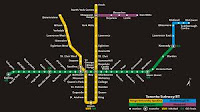 |
| Toronto's new trains will be in service starting this December or January. Image: www.ttc.ca. |
NEW SUBWAY TRAINS IN TORONTO
Toronto is getting some new subway trains.
There will be 70 new trains, with six cars each. They will cost about $1-billion. The governments of Canada, Ontario and Toronto are all chipping in money to buy the new trains.
Another neat thing about the new trains is that, although there are six cars in each one, they will all be connected inside. So whichever car you get on, you’ll be able to see (or walk) all the way from the front to the back of the entire six-car train. Between the cars is a flexible strip of floor that you can walk on, which connects the cars but still lets them turn independently.
.jpg) |
| Toronto's old subway trains will continue to run on the Bloor line. Image: spacingtoronto.ca |
And, there won’t be poles in the middle of the cars any more. That will also give passengers more room to move around. There will still be lots of poles along the sides to hold onto.
The new trains will begin running, on the Yonge (north-south) line, in December or January, although riders may see them being tested in the tunnels before then. The old cars will be moved to the Bloor (east-west) line or retired.
The new subway trains will cost 1 billion dollars. That is a lot of money! Do you think this is money well-spent? Explain your answer using evidence from the text and your own ideas.
express personal opinions about ideas presented in texts (OME, Reading: 1.8)
make judgments and draw conclusions about ideas in texts and cite stated or implied evidence from the text to support their views (OME, Reading: 1.8)
A noun is a part of speech. It can be a person, place or thing. Some nouns that are in the article are: subway (thing), Toronto (place), floor (thing).
Ask your students to circle all of the nouns in the article.
 |
| Toronto's subway line - this map shows the Yonge line and the Bloor line. |
As a class, discuss which nouns are proper and which are common. Explain that proper nouns must always start with a capital letter.
Extensions
Why do you think it is important for a city to have a public transit system?
Why do you think it is important for a city to have a public transit system?
If you were on the planning committee for the new subway, are there any other features that you would add to improve the new subway cars?
How much is 1 billion? Use drawings, numbers or manipulatives to show this amount.

.jpg)
















